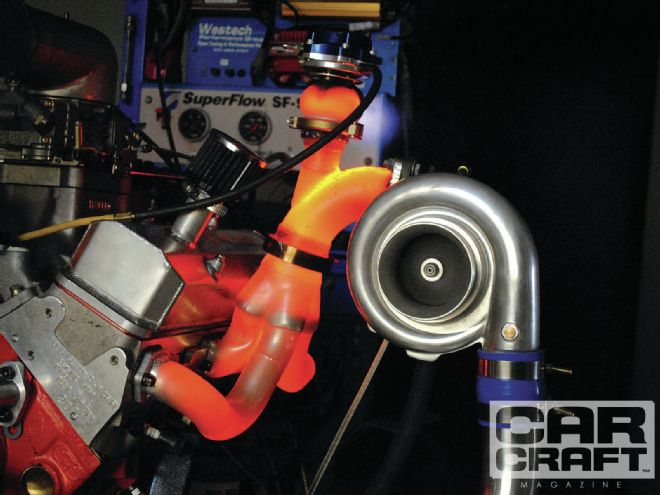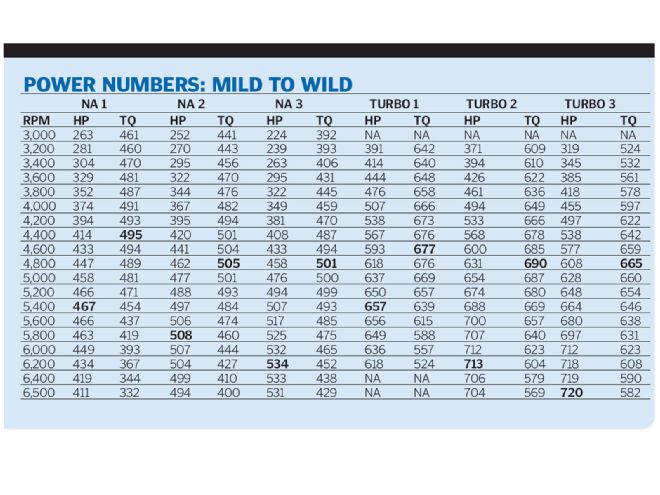
We've been toying with turbos and turbo cams for a few years now, and the more we think we know, the more we discover how much more there is to discover. Last year, we ran a theoretical piece on camshafts and their effect on horsepower ("The Truth About Camshafts and Turbochargers," June '11) and came away with a gem from noted engine builder Kenny Duttweiler: He told us to treat a properly sized, high-efficiency turbo motor like a naturally aspirated engine. In terms of turbo cam selection, this translates to choosing one based on engine size, head flow, and desired powerband.
To test the sage's advice, we set up a series of experiments using a 420-inch small-block and a pair of 76mm twin turbo. This built-for-boost stroker combination is none other than the Two-Headed Animal we built in the Aug. '11 issue ("Building the Two-Headed Animal"). It features a Dart block, K1 crank and rods, and JE forged slugs. Topping the beast was a set of CNC-ported 233 Brodix heads and a matching single-plane intake. We also installed a Jesel shaft-rocker system, a Milodon pan and oil pump, and a Holley 950 Ultra HP carburetor. The idea was to compare three different cam profiles on the twin turbo stroker, ranging from mild to wild, then perform the same test after adding the turbo system. Simple enough, right?
Comp Cams provided three custom single-pattern hydraulic roller cam, wherein the intake and exhaust lobes shared the same lift and duration figures. The first (mild) turbo cam offered 0.578 lift, 210 degrees of duration at 0.050 and a 112-degree lobe-separation angle (LSA). Turbo Cam number two stepped things up to 0.594 lift, 230 degrees of duration and 113 LSA, while the wildest cam (turbo cam number 3) provided 0.605 lift, 248 degrees of duration and a wider 114-degree LSA. Though the lift differed by just 0.027, the significant change in duration would shift the power production much higher in the rev range, especially when combined with our free-flowing heads and single-plane intake.
First up was cam number one. The mildest grind of the bunch illustrated what happens when you under-cam a normally aspirated twin turbo stroker motor. The minimal duration produced peak power at just 5,300 rpm, offering peak numbers of 467 hp and 495 lb-ft of torque at 4,400 rpm. Torque production exceeded 475 lb-ft from 3,500 rpm to 5,100 rpm, making for a healthy but rather narrow 1,000-rpm powerband (peak torque to peak horsepower) from this 8.5:1 compression engine.
Cam number two was next, and the increased duration both upped the power and increased the effective engine speed. The peak power output of 508 hp came at 5,800 rpm (an increase of 500 rpm from the small cam), while the peak torque of 505 lb-ft came at 4,700 rpm (up by 300 rpm), but the powerband remained the same around 1,000 rpm. The torque curve (exceeding 475 lb-ft) increased in size from 3,800 rpm to 5,500 rpm, an effective shift of 300 to 400 rpm more than the smaller cam.
This trend continued with the wildest of the three cams, which produced 534 hp at 6,200 rpm and a slightly lower 501 lb-ft at 4,800 rpm. This cam had the widest 1,400-rpm powerband (which is still somewhat narrow), but it lost 4 lb-ft of torque while shifting peak horsepower by 400 rpm while peak torque rpm remained constant. As is typically the case with cam swaps, eventually peak torque is unchanged (or lowered slightly) and the horsepower gains at higher engine speeds are accompanied by losses lower in the rev range. Basically, you are trading low-speed torque for top-end power. The intended application should dictate the best possible power curve, but for most street applications, low- and mid-range torque make a car much more fun to drive than one with an engine built for peak power.
After running through our three cams in naturally aspirated trim, we performed the same test with some boost. The turbos, the intercooler, and majority of the plumbing (aluminum and steel tubing, couplers, clamps, and hardware) were supplied by CX Racing (CXRacing.com). Having run them successfully a number of times in the past, we selected a pair of 76mm turbos and combined them with a dual-core, air-to-water intercooler. Given the low boost level employed during testing, the intercooler was probably not necessary (especially on the blow-through carb application that further cools the intake charge), but cooler air is always better. We fed the turbos with a pair of shorty headers run upside down, mounting the turbos with V-band clamps and T4 turbo flanges. Completing the homemade turbo "kit" were a pair of 45mm Hypergate wastegates, a Race Port blow-off valve, and a manual waste-gate controller, all supplied by Turbo Smart. The turbo combination also necessitated the switch to a Holley carburetor modified for boost by Carburetor Solutions Unlimited (CSU) and a dedicated, blow-through carb bonnet.
With our twin-turbo small-block up and running, it was time for more cam testing. First up was the mildest cam, which produced 657 hp at 5,400 rpm and 677 lb-ft of torque at 4,600 rpm. Adding just 5.9 psi of boost increased the power output of the small-block by 190 hp and 182 lb-ft of torque. The torque curve was impressive, bettering 650 lb-ft from 3,700 rpm to 5,200 rpm, and the powerband ranged from 4,600 to 5,900 for a 1,300-rpm spread (wider than the naturally aspirated curve by 300 rpm). Despite the oversized turbos (capable of exceeding 1,500 hp), we had full boost available at 3,000 rpm, though the engine dyno does subject the motor to an artificial load not replicated on the street or strip.
Cam number two increased the power output substantially, with a jump to 713 hp at 6,200 rpm and 690 lb-ft at 4,800 rpm. Note that similar to the NA testing, the peak numbers were up, but so was the engine speed at which they occurred. The same 5.9 psi improved the power output of the NA combination by 205 hp and 185 lb-ft of torque. True to form, the medium cam shifted the effective torque curve, bettering 650 lb-ft from 4,100 rpm to 5,700 rpm (a change of 400 to 500 rpm over the smaller cam). This produced a powerband of 1,400 rpm, a full 100 rpm broader than the small cam curve and 400 rpm more than the naturally aspirated curve. So far, the cam swaps on the turbo motor were mirroring the gains experienced on the NA combination.
The final cam to be tested was the wildest of the three, but the gains achieved on the naturally aspirated motor did not translate to the turbo combination. Running the same boost level as the previous two cams, the turbo combination produced 720 hp at 6,500 rpm and 665 lb-ft of torque at 4,800 rpm. The peak power was up slightly over the smaller cam but was nowhere near the extra 26 hp offered in NA trim. In fact, the turbo motor's power output was down compared with the middle cam. It seems this cam was a tad on the wild side for our turbo application, so unlike the naturally aspirated stroker, bigger was actually not better. Comparing the big cam torque with the small cam at 3,600 rpm (typical converter stall speed), the longer-duration cam lost 87 lb-ft and 59 hp.
Having a turbo stroker on the dyno (even with a less-than-ideal cam) and running just 5.9 psi made us hungry for more boost. Not wanting to hurt The Animal, we cranked up the boost just a smidge to about 9 psi. Even those few extra pounds of boost had a significant impact on power, allowing the twin-turbo 420 to belt out 862 hp and 816 lb-ft of torque. With a couple more turns of the wastegate controller, this becomes an easy 1,000hp small-block.
In naturally aspirated trim, increasing the lift and duration had a positive and predictable effect on the power curve of the stroker small-block. With each successive increase in lift and, more important, in duration, the peak power output increased from 467 hp to 508 hp to 534 hp. The single-pattern cams were likely not ideally suited to the naturally aspirated application, but the changes show a general trend toward increased power and engine speed. Note that the peak power outputs of each combination occurred progressively higher, starting with 5,300 rpm for the mild cam, edging up past 5,800 rpm, and then 6,300 rpm for the larger two. The torque peaks revealed the same trend, increasing from 4,400 rpm with the small cam to 4,800 rpm with the largest cam. This trend continued with the first two cams once we installed the turbos from CX Racing, but the turbocharged motor did not respond favorably to the wildest cam profile. The peak power output was up by just 7 hp (compared with a gain of 26 hp naturally aspirated), and the larger cam lost power to the smaller grind from 3,200 rpm to 6,100 rpm. For our turbo application, the second cam was the hot setup.
 Power Numbers
Power Numbers
We spoke to Matt Maxwell and Billy Godbold at Comp Cams to get their thoughts about what was happening. "I think this will demonstrate what we generally expect with turbo applications," says Godbold. "In general, the high air density allows a drastic increase in the mass flow [power], but the flow velocity is lower (imagine lots of closely spaced atoms moving slower compared with wide-spaced atoms moving faster) Balanced turbo applications almost act like N/A except with heads [that have] tremendous flow (imagine a 350-cfm intake head becoming 700 cfm ). The rule of thumb has always been the more air the head flows, the smaller cam you need. In turbo applications, the backpressure is very important. If the backpressure is more than 5 to 10 pounds above the boost, then you can have drastic backflow during overlap. In such cases, the cams have to have reduced overlap when compared with N/A applications. In this case, I am not sure if the cams were just too big or if the backpressure resulted in severe backflow. The measured backpressure and exhaust residue is what you need to know."